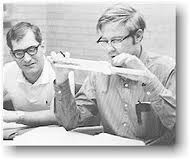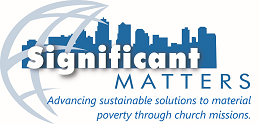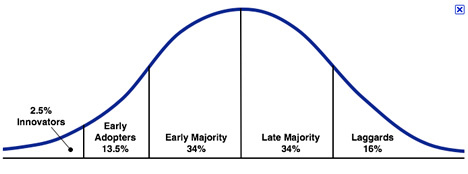A Changing World
 Learning in every area of life is a building proposition. We build on foundational knowledge and experience an ever deepening and more sophisticated understanding of things, both intellectually and practically. First we learn our numbers, and then we learn arithmetic which becomes the means for solving algebra, geometry and trigonometry which in turn we use to do calculus. We don’t get to the more complex and sophisticated disciplines of math except that we first learn our numbers. The same is true in the realm of the practical or “doable” things of life. If I want to be a great guitarist I first have to learn to tune a guitar, strum with my right hand, form chords with my left and keep time. Or, as the saying goes, we learn to walk before we run.
Learning in every area of life is a building proposition. We build on foundational knowledge and experience an ever deepening and more sophisticated understanding of things, both intellectually and practically. First we learn our numbers, and then we learn arithmetic which becomes the means for solving algebra, geometry and trigonometry which in turn we use to do calculus. We don’t get to the more complex and sophisticated disciplines of math except that we first learn our numbers. The same is true in the realm of the practical or “doable” things of life. If I want to be a great guitarist I first have to learn to tune a guitar, strum with my right hand, form chords with my left and keep time. Or, as the saying goes, we learn to walk before we run.
This principle is more than an interesting observation; it represents a driving force embedded in both human experience and nature itself. We are not satisfied with either our understanding of things or our accomplishments. The human race is “hard-wired” to confront the forces of entropy in an ever attempt to push for more and better. We are not satisfied with yesterday’s ways; there has to be better ways of doing things, better ways of seeing and understanding things. And although it is true that there are such things as “timeless truths” those truths seldom represent both the beginning and ending of a subject but rather the foundational truths or principles upon which we slowly but surely, over time and much trial and error, discover the “calculus” of the subject at hand.
Such is the case in the realm of charitable good, philanthropy and what the church calls “missions.” The whole realm of what it means to do good and help others in need is experiencing the emergence of a calculus of compassion and what it means to truly care. Caring about people is no longer simply a matter of helping them but rather helping them in ways that are sustainable, potentially scalable and within the hard but reasonable stretch of the context to manage and lead long-term. The hard but reasonable stretch of the context is another way of describing a strengths-based, patient capital approach to doing good. It has become abundantly clear that helping others by simply alleviating a need for them creates dependency and additional needs. We have to work with the strengths of the people we are trying to help, mobilizing and deploying resources in a slow and steady process so that over time they lift themselves out of poverty.
 The traditional model of helping has been a simple equation; need + charitable resources = relief and everybody is happy…for the moment. The charitable side of the equation gets a feel good fix by seeing the faces of those they help and the receiving side gets their need met while the service providers are able to oversee the whole deal and tell the story so they can raise the next round of funds and do it all over again. But alas! The funders grow weary of meeting the same need over and over again and the grateful faces of those they help are not enough to satisfy their philanthropic itch. Recipients grow more dependent in the process learning to work the system for their advantage and slowly but surely lose the drive and personal dignity it takes to lift oneself from the grip of poverty. And service providers, living in this impossible tension, simply burn out. There is absolutely nothing sustainable or scalable in this model.
The traditional model of helping has been a simple equation; need + charitable resources = relief and everybody is happy…for the moment. The charitable side of the equation gets a feel good fix by seeing the faces of those they help and the receiving side gets their need met while the service providers are able to oversee the whole deal and tell the story so they can raise the next round of funds and do it all over again. But alas! The funders grow weary of meeting the same need over and over again and the grateful faces of those they help are not enough to satisfy their philanthropic itch. Recipients grow more dependent in the process learning to work the system for their advantage and slowly but surely lose the drive and personal dignity it takes to lift oneself from the grip of poverty. And service providers, living in this impossible tension, simply burn out. There is absolutely nothing sustainable or scalable in this model.
Sustainability
There is a lot of talk these days in the world of aid and relief to the poor referring to the idea of sustainability. I was reminded recently of how polarizing those words can be and how important it is to define what you mean on the front end of a conversation when using those terms. We were at a conference for churches and others in the faith-based world that are focused on moving their missional efforts away from emergency relief and individual betterment toward community development that is sustainable. I was talking about some of the things we are involved in both here in the US and internationally with a college economics professor. There seemed to be a lot of general agreement and interest in what I was sharing until I used the word “sustainable.” As I pressed into his reaction it became clear that the vernacular of “sustainability” meant something entirely different to him than it did to me. All of the conversations he had been a part of that referred to sustainability had to do with conserving and stewarding the world around us. It was about protecting the environment and supporting “green” policies in business and society as a whole. Although that is a much needed conversation and a worthwhile pursuit I was, and am, using the word in a very different way. Let me explain.
The world of philanthropy and charitable good is asking questions about sustainability primarily from a resource point of view. “How long will we have to fund this effort if we get involved?” “Will this ever be self-sustaining or will it always require outside funding and leadership?” Funders aren’t the only ones in the equation asking these kinds of questions. Those receiving our aid, especially a growing number of those in leadership, are asking the sustainable question as well. They recognize that the billions of dollars given to aid both at home and abroad over the past 50 years has done little to lift people, communities and countries out of their circumstances but rather created greater degrees of dependence. The question they are asking is, “How sustainable is the aid approach and the dependence it creates along the way?” More importantly, “How does that dependence ever really address poverty or protect the personal dignity people need to lift themselves out of poverty?” What many of us are asking is how we can do the good we want to do and help the people and causes that matter the most to us in ways that, sooner than later, lead people to a place where they can do that good themselves and no longer need our charitable resources. That, to put a fine point on it, is what I am referring to as I use the word sustainability.
The momentum for more sustainable models of helping is building across the world today. These models are based upon a fundamentally different equation. In addition to meeting real needs they also include sustainability and scalability as necessary outcomes, a strengths-based, patient capital approach as the necessary means and a metrics based approach to results that favors verifiable evidence over anecdotal stories. This calculus of compassion is a different way of helping that requires additional players and different ways of thinking that can account for and manage complexity. But most importantly, because of complexity, it requires a commitment to problem-solving that must rise above simplistic solutions and survive beyond the initial enthusiasm that most people and groups have demonstrated through their helping efforts in the past. This kind of helping is not simple math nor is it a quick and easy fix. It is a slow and steady process that takes time, collaborative learning and no small amount of trial and error on the part of the 2.5
Innovation
The 2.5 comes from Everett Rogers famous work on the “Diffusion of Innovations” in which he demonstrated what has become a well-established fact; that innovation always comes from a very small group of people (2.5%) within a population. This group he labels as “innovators” and they think, act and even talk differently than others within the same group. It is this small group of innovators that always develop new ideas and paradigm shifts and with the help of “early adopters” move those innovations forward and eventually into the mainstream. However, and this is key, the path to moving an idea forward and into main stream is not by convincing the masses on the front end but rather accelerating the learning curve of the 2.5. They will eventually demonstrate new models which will then convince the “seeing is believing” crowd or middle of the bell curve. The fundamental difference between people in the middle of the bell curve and the 2.5 is that one can see it before they experience it and the other can never see it until they experience it. It is this 2.5 group that we need to focus on because they are the key to innovative change. Bob Buford, sharing a conversation he once had with Peter Drucker said it this way, “If you want to move the middle of the bell curve help move the front end (the 2.5) because the distance between the middle of the bell curve and the front is a constant.” The organization I lead, Significant Matters, is committed to working with the 2.5 in the world of philanthropy and charitable work especially in the faith-based world. One of the main purposes for writing this is to suggest how we can create the space to help move the 2.5 in the world of philanthropy, charitable good and the church’s missional efforts faster and farther toward models that are sustainable and potentially scalable. But first let me make an important distinction in the realm of innovation.
When it comes to innovation there are two very distinct and different kinds of innovation known as continuous and discontinuous. Continuous innovation is all about the incremental innovations needed to sustain something in its current model. Discontinuous innovation is a type of disruptive innovation that, if adopted, will require a significant change in behavior and produce a new model. The kind of innovation I’m writing about and what I believe is relevant and most important to the subject at hand is discontinuous innovation. The trajectory of our charitable endeavors and the church’s missional efforts is not about incremental changes to the current model but rather a disruptive, discontinuous innovation that when adopted will require a significant change in behavior for non-profits, philanthropists, churches and all who want to help in sustainable, potentially scalable ways. In my experience there are a lot more people who can do the work of continuous innovation and far less that can actually do the work of discontinuous innovation. In fact, to bring people to the same table for problem solving on the basis that they are innovators misses the point. The one group is looking for ideas on how to make the current model better…more effective…more efficient. The other is looking to discover an entirely new way of doing things…new models of how we do what we do. The more important question is, “Are you a continuous or discontinuous innovator in this particular subject?” This distinction is important because supporting discontinuous innovation and moving it forward is not about knowing in advance, it’s about discovering along the way! We only slow the discovery process down and frustrate the participants when we try and mix continuous and discontinuous innovators in an attempt to come up with new and innovative ideas no matter what the particular subject happens to be.
The truth is, we have only begun to scratch the surface on how to approach our charitable work and missional efforts in ways that are fundamentally different from what we have been doing throughout the ages. Our best models are a mixed bag at best. Much of what we are currently doing under the name of “sustainable” is the same work dressed up in new language. Funders, service providers and the people we seek to help are simply learning new steps to the same old dance and for many skeptics this “sustainability kick” has understandably become the next big fad. But for some (the 2.5) it’s more than a fad. It’s a new reality in the making. A new reality, that in 10-15 years will make its way to the middle of the bell curve and become the new normal for how we do our charitable work and missional efforts. But for now all of this exists somewhere between the “fad” that it is for many and the theoretical possibility it is for those committed to forging a new way.
What follows is a look at what I currently see happening in this space, where I believe it is headed and some suggestions on how we can help it along even as we help shape it in the process. Some of the things we will look at include the growing role that marketplace people will play in the world of charitable good and the church’s missional efforts, why metrics matter more than anecdotes and why the “expert” is a figment of their own imagination. We will explore why traditional service providers and pastoral staff are ill-equipped to lead this new approach to doing good and why most marketplace people will bail from the process rather than push through the limitations of their own ignorance and arrogance. I’ll explain why I think business people and philanthropists screaming the loudest for more sustainable approaches are speaking out of both sides of their mouth when they refuse to fund “overhead,” leadership and the trial and error of research and development. We will take a look at why focusing on efficiency, effectiveness and eliminating duplication of services will not lead to anything new, just different configurations of what we already have.
One last thought that bears stating at the front end has to do with the broad subject of faith, religion and the church. My background has been primarily within the faith-based world of protestant Christianity and the good churches want to do in this world. By definition, the church has an interest in helping people not only in the here and now but also in the hereafter. The conditions and priorities of those two motives create a lot of tension, debate and controversy at times. I will touch briefly on that tension and describe some churches and initiatives that I see working this tension out in some very practical and constructive ways around our world today. However, for the sake of this writing, my main focus is on the good that both the faith-based community and secular philanthropy want to accomplish in the here and now and leave the missional work of the hereafter for another conversation. Not because these groups are congruous or because their underlying motives and assumptions aren’t important. But rather because I believe both religious and secular philanthropy at the very least share a common motive of wanting to do the most good for the most people in the shortest amount of time. We are involved in the same learning curve and for the sake of those we seek to help there is much advantage to learning together in the belief that it will accelerate that learning curve and that may very well be the greatest good we can do at this stage of the journey.
Despite all the changes, challenges and outright chaos this represents I believe we are on the verge of a fundamentally different way of doing good in this world; of helping overcome the effects of poverty and the many forms of human suffering. I believe this calculus of compassion is one of the most important transitions going on in the world today.




Leave A Comment
You must be logged in to post a comment.